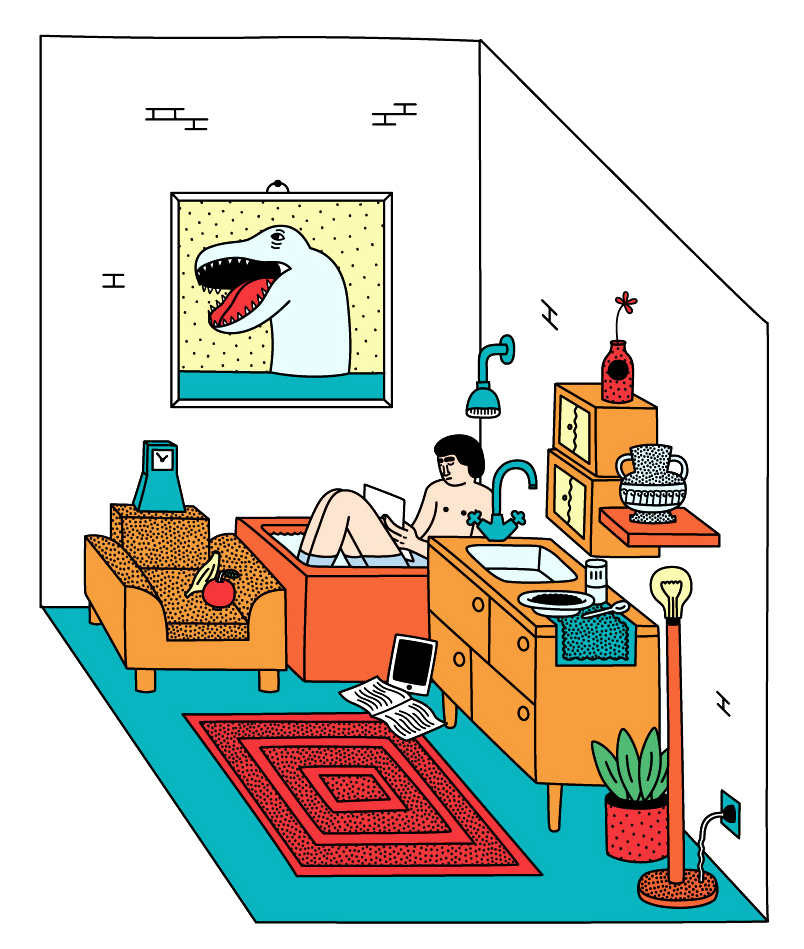Cloud Living
We're all used to keeping our data in the cloud by now, but is that mentality beginning to seep into the physical world?

Cloud computing has transformed our relationship with digital information. We no longer need to possess media and work files on our machines – we just need access to them at the right time. As a result, we can lead much more flexible lives.
What if we could do the same with physical objects? MakeSpace, a new storage start-up based in New York, is trying to apply the principles of cloud storage to real items. It allows people to store stuff in a secondary place away from their home. But, unlike other storage units – whose services involve reams of tape, lots of labelling and the hassle and expense of hiring a van to take things there – MakeSpace makes everything accessible online. Say it’s spring and you no longer need your warmest coats and scarves.
MakeSpace will send a courier to your home to pick up your winter storage boxes. These are then photographed and placed in local MakeSpace storage, while the images are uploaded to the MakeSpace site. In autumn, when you need your winter items back, you can simply look through the images on the MakeSpace site and order the relevant box for delivery to your home. “It’s a closet in the cloud,” explains Rion Harmon, head of marketing at MakeSpace.
“When you put something in the cloud it’s no longer on your computer, but you know it’s somewhere safe and you can get it back any time.”
MakeSpace isn’t the only company offering this sort of service. Boxbee, which describes itself as an “urban storage valet”, launched last year and offers a similar cloud storage service for under $10 per month. It’s the simple living movement towards people wanting to have a less heavy footprint on Earth.
The obvious advantage of both services is that urban homes can now be freed of stuff – a growing issue as cities become denser, and the space we have for belongings, furniture and other accumulated items comes at even more of a premium, both psychological and financial. It might be that we need to keep some of them in a secondary place that doesn’t interfere with our daily lives – or affect our rent. “Maybe in a suburban area you can put some stuff in a garage, but the problem we’re trying to solve is people in cities who want to lead a life that’s not overwhelmed by stuff they don’t need,” explains Harmon. And using a cloud-style storage system helps to make all that stuff seem at arm’s length away.
Susan Saegert, professor of environmental psychology at the City University of New York Graduate Centre, has discovered that living in cramped conditions can put stress on relationships and create behavioural problems for children. As she explains, there are other pressures on us to give up stuff. “It’s the simple living movement towards people wanting to have a less heavy footprint on Earth,” she says. “People are talking a lot about feeling they’re spending too much money on stuff and it’s clouding out work, leisure and artistic opportunities.”
If living space is smaller, then it might not serve as a form of public expression of yourself. Belongings might not be the only thing we decide to outsource in this way. What if we could locate parts of our home externally? There may be certain amenities that, if really pushed for space, we could do without.
Industrial designer Konstantin Grcic explores this in his proposal for a small urban home with no bathroom or kitchen, part of his “Panorama” solo show, on view at the Vitra Design Museum in Weil am Rhein, Germany, until 14 September 2014. Grcic envisages that urban residents of the future would take showers in their local gym and dine out in nearby restaurants – not too far-fetched, given the number of city inhabitants who lead a lifestyle rich in both entertainment and sporting activities.
To live like this would, of course, require us to sever some of the subtle relationships we have with our belongings. There seems something very human about keeping the odd trinket given as a gift or picked up from travels abroad. Sam Gosling, professor of psychology at the University of Texas at Austin and author of Snoop: What Your Stuff Says About You, explains that there are several reasons why we accumulate things. Aside from functional requirements and the inevitable items we gather just from existing over time, many have to do with being able to express our personalities.
“If living space is smaller, then it might not serve as a form of public expression of yourself,” says Gosling. “If you can’t have a proper-sized living room, than you can’t have all the props.”
That said, he adds, it’s now likely that we have alternative places to express our personalities, such as social media, which could alleviate the need to show who we are through the objects we own. Cloud living could do more than solve some of the problems of micro-living and having too much stuff. It also offers people the chance to be much more flexible over where and how they live, in much the same way that online cloud storage lends flexibility to working lives. “It’s the whole idea of the sharing economy – the things in life that you don’t need to possess, maintain and find a space for,” says Saegert.
One of Harmon’s favourite MakeSpace customers uses the service in conjunction with property rental website Airbnb to lead an entirely nomadic existence. A photographer who works around the world, he no longer requires a fixed home full of personal items – he simply needs occasional access to his belongings. “He comes to New York a lot and keeps his stuff here in MakeSpace,” says Harmon.
“When he’s in town, he rents an Airbnb apartment and then orders the necessary items from MakeSpace that he needs for the duration of his stay.” Other people use the service when they move home, sending items into MakeSpace ahead of their move and ordering their possessions to the new place once they’re fully settled. “It’s cool to watch people hack us in all these ways,” says Harmon.
And this is the point of the cloud and why it works: it allows people the freedom to go about living in a way that suits them.
Originally printed in Protein Journal Issue #13.
Illustrations by Martina Paukova.


